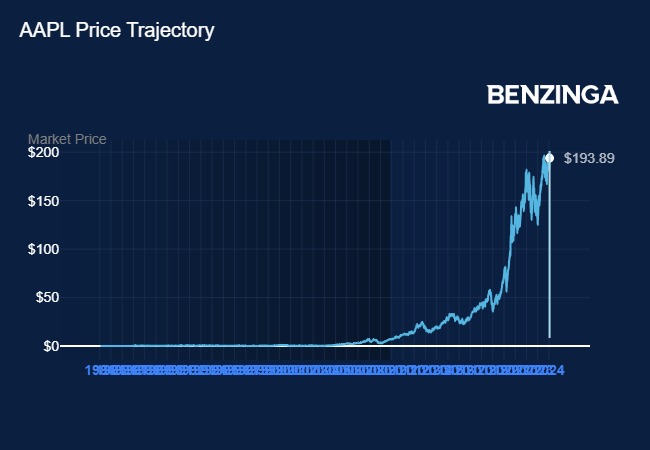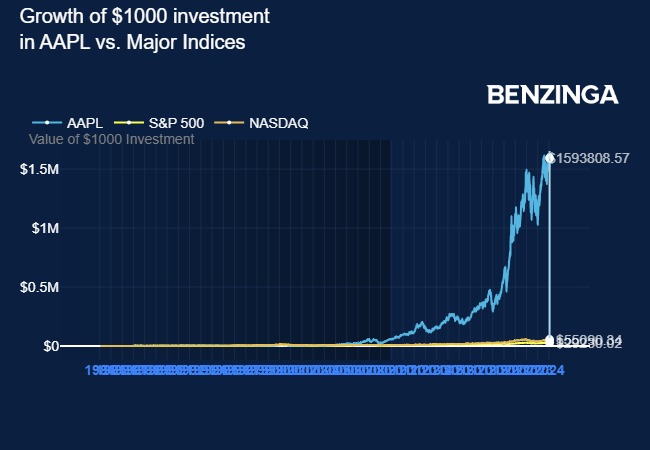Zinger Key Points
- Apple launched the Macintosh 40 years ago, following the iconic “1984” Super Bowl ad.
- If you had invested $1,000 in the company back then, here’s how much your investment would be worth.
- Markets are swinging wildly, but for Matt Maley, it's just another opportunity to trade. His clear, simple trade alerts have helped members lock in gains as high as 100% and 450%. Now, you can get his next trade signal—completely free.
The iconic Macintosh has turned 40. Launched on Jan. 24, 1984, the Mac would set the tone for Apple Inc. AAPL future and change the much-wider personal computing industry forever.
The Macintosh was not Apple's first personal computer; it was the fourth computer launched by the Steve Jobs-led company. However, it had the most significant impact on personal computing for two reasons: it was more affordable and brought a graphical user interface (GUI) to the masses.
The Apple I, Apple II, and the Lisa preceded the Macintosh's launch. Despite critical acclaim, though, Apple did not manage to deliver an out-and-out hit.
But that was about the change, and there was more than just the Macintosh for Apple to thank for.
After Xerox granted Apple and its engineers a visit to Palo Alto Research Center's facilities in 1980, Jobs understood that the future of computing was graphical. He and his team got down to work and started developing a GUI for a new computer called Apple Lisa, named after Jobs' daughter.
However, infighting in the team led to Jobs being pushed out of the division, and that was perhaps a blessing in disguise for both him and Apple. Jobs began working on the Macintosh after his fellow co-founder Steve Wozniak stepped back from the project due to a plane crash earlier.
Remembering Apple's Iconic ‘1984' Super Bowl Ad
While the Macintosh team was busy preparing the computer for launch, Jobs teamed up with Ridley Scott for a massive push at the Super Bowl XVIII.
What followed was Apple's iconic "1984" Super Bowl ad that was called everything, from a "watershed moment" for Apple to a "masterpiece."
It has also been called the greatest TV advertisement of all time by TV Guide.
Apple marketing guru Regis McKenna called the ad "more successful than the Mac itself."
Changing Personal Computing Forever
The original Macintosh seems absurd, with its diminutive display and slightly bulky appearance. However, that was a different time when 128 kilobytes of memory was insanely costly, at $1,269.
For context, you can buy the top-tier iPhone 15 Pro Max today with far, far more processing power, powerful cameras, a stunning display, and 8,192 times more memory than the original Macintosh's 128KB.
However, Macintosh's achievement – and indeed Jobs' – was that it introduced the ordinary user to a GUI. Armed with a mouse and a user interface that finally felt friendly after users were forced to use a command-line interface like tech wizards.
Macintosh caught people’s fancy – Apple managed to sell over 70,000 units in the first four months despite the hefty price tag of $2,495 (about $7,500 in today's terms.)
While the Apple Lisa division was the biggest contributor to Apple's revenues until then, Macintosh's success changed that and the future of computers.
The rest, as they say, is history.
Let's look at how Apple stock has fared since the company launched Macintosh 40 years ago.

Apple's stock, adjusted for stock splits and other corporate actions, was $0.121652 on Jan. 24, 1984.
Its stock price today is $193.89, which is an increase of 159,281% during this period.

If you had invested $1,000 in Apple stock on Jan. 24, 1984, today, you would have $1,593,809.
Likewise, if you had invested $1,000 in an index fund replicating Nasdaq, you would have $55,090.
A similar $1,000 investment in an index fund that replicates the S&P 500 would be worth $29,230.
The Apple Silicon-Powered Future
Apple has since scaled several highs, launching several industry-defining products like the iPod, iPhone, iPad, Apple Watch, and even AirPods.
Beating at the heart of most of these products is a piece of silicon – a chipset that tells the device what needs to be done and how.
Apple designed its first chipset in 2010 – nearly 34 years after it was born. Initially, the company used its design and partnered with Samsung Electronics Co Ltd. SSNLF and Imagination Technologies' PowerVR.
Having started off with the iPad, Apple silicon powers almost every product in the company's portfolio, right from iPhones, Apple Watches, iPads, and even Macs now, after having relied on Intel Corp. INTC until as recently as 2019.
Apple is not resting on its laurels, either. It is looking beyond the iPhone with its $3,500 Vision Pro headset that is off to a good start, according to analyst Ming-Chi Kuo.
Apple is currently the largest company in the world by market capitalization, at $3.017 trillion. Wedbush’s Dan Ives believes that the iPhone maker could touch $4 trillion market capitalization by the end of 2024.
Check out more of Benzinga's Consumer Tech coverage by following this link.
Photo courtesy: Wikimedia
Edge Rankings
Price Trend
© 2025 Benzinga.com. Benzinga does not provide investment advice. All rights reserved.
Trade confidently with insights and alerts from analyst ratings, free reports and breaking news that affects the stocks you care about.